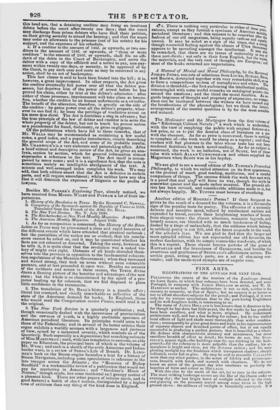Besides Mr. PARKER'S Exploring Tour, already noticed, we have received
from Messrs. WILEY and PUTNAM a lot of their im- portations. 1. History of the Revolution in Texas. By the Reverend C. NEWELL. 2. Conspiracy of the Spaniards against the Republic of Venice in 1618. Translated from the French of the Alibi': Si'. REAL. 2. Conspiracy of the Spaniards against the Republic of Venice in 1618. Translated from the French of the Alibi': Si'. REAL.
4. The Knicherbocker, or New York Monthly Magazine. August 1839. 5. The American Monthly Magazine. August 1838.
1. As far as composition is concerned, the History of the Revo- lution in Texas may be pronounced a clear and rapid narrative of the different events which have attended that piratical outbreak ; but the partialities of the author are so evident, that his conclu- sions cannot be relied on, and it may be questioned whether his facts are not coloured or distorted. Taking the story, however, as he tells it, it is quite clear that the revolution was a naked vic- tory of might over right. Outcasts of all kinds obtruded them- selves into the province in opposition to the fundamental coloniza- tion regulations of the Mexican Government; when they increased and waxed strong, they took up arms without even colourable pretexts, and at last proceeded to open war. Besides an account of the incidents and actors in these scenes, the Texan divine draws a flaming picture of the beauties and advantages of the new state ; but the whole is so characterized by the spirit of a pro- jector beating up for colonists, that we feel disposed to place little confidence in the statements.
2. The translation of ST. REAL'S history is a puerile affair ; literal but cramped, and chiefly remarkable as indicative of the state of the American demand for books. Iii England, those who would read the Conspiration contre Venise, could read it in the original.
3. The New York Review is a quarterly publication ; and, though occasionally dashed with the narrowness of provincialism and the rawness of youth, is a highly creditable specimen of American periodical literature. Its principles would seem to be those of the Federalists; and in several of its better articles their organ exhibits a worldly acumen with a largeness and justness of view, spiced by a measured severity, which reminds us of the Quarterly. Such especially is a depreciatory but searching estimate of Miss MARTINEAU ; such, with less temptation to sarcasm, an able paper on Education, the principal basis of which is the volume of Mr. WYsE; and such is a sketch of the early American and Indian border wars, in a review of STONE'S Life of Brandt. Dr. LARD- NER'S book on the Steamengine furnishes a text for a history of Steam Navigation, including some speculations in reference to the late voyages across the Atlantic ; the "Remains of Bishop Sandford' is a workmanlike review of a publication that would not pay for reprinting in America ; and " Gardiner's Music of Nature," though crude, has some incidental and gossipy matter of a pleasant kind. There are other papers of inferior merit, and (a good feature) a batch of shot t notices, distinguished by a higher tone of criticism than any thing of the kind done in England. 4,5. There is nothing very particular in either of thesepubli. cations;except as they furnish a specimen of American ntentm. periodical literature; and this appears to be somewhat after rill fashion of our old magazines, being equally verl»se and quell: unreal. It may be noted as a sign of the times, that a won', though concealed feeling against the abuses of Ultra llerneera4 appears to be spreading amongst the intellectual. It may al be remarked, that there are no traces of nationality in env of these periodicals : not only is their form English, but the topic the materials, and the very cast of thought, are European; add most of the books reviewed are importations.


























 Previous page
Previous page